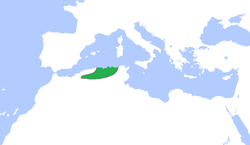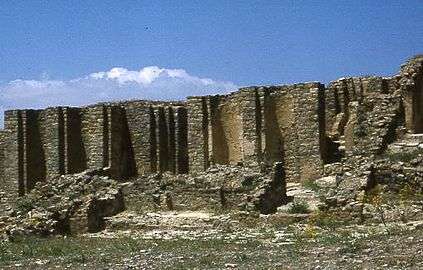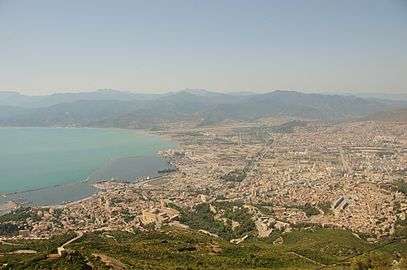Hammadid dynasty
The Hammadid dynasty was a Sanhaja Berber dynasty that ruled an area roughly corresponding to north-eastern modern Algeria between 1008 and 1152. Its realm was conquered by the Almohad Empire.
Hammadid dynasty | |||||||||
|---|---|---|---|---|---|---|---|---|---|
| 1014–1152 | |||||||||
 The Hammadid dynasty (green), c. 1100 | |||||||||
| Capital | Beni Hammad (until 1090) Béjaïa (after 1090) | ||||||||
| Official languages | Arabic, Berber | ||||||||
| Religion | Islam | ||||||||
| Government | Monarchy | ||||||||
| Sultan | |||||||||
• 1008–1028 | Hammad ibn Buluggin | ||||||||
• 1121–1152 | Yahya ibn Abd al-Aziz | ||||||||
| History | |||||||||
• Established | 1014 | ||||||||
• Disestablished | 1152 | ||||||||
| |||||||||
| Today part of | |||||||||
Part of a series on the |
|---|
| History of Algeria |
 |
|
Prehistory
|
|
|
|
Modern times Ottoman Algeria (16th - 19th centuries)
French Algeria (19th - 20th centuries)
|
|
Contemporary era |
|
Related topics
|
The Hammadid dynasty's first capital was at Qalaat Beni Hammad. It was founded in 1007, and is now a UNESCO World Heritage Site. When the area was sacked by the Banu Hilal tribe, the Hammadids moved their capital to Béjaïa in 1090.
History
In 987 and 989, al-Mansur ibn Buluggin, the emir of the Berber Zirid dynasty, appointed his uncle Hammad ibn Buluggin as governor of Ashir and western Zirid lands. Hammad subsequently defended the territory against Zenata incursions and was granted additional lands by al-Mansur's successor Badis ibn Mansur. In 1007 and 1008, forces under Hammad left Ashir and built a new citadel-capital, Qalaat Beni Hammad (also called Al Qal'a of Beni Hammad), in M'Sila Province in the Hodna Mountains; a thriving city sprung up around the fortress.[1]
In 1014, Hammad declared his independence from Zirid suzerainty and switched his spiritual allegiance from the Shi'a Fatimid caliphs to the Sunni Abbasid caliphs of Baghdad. The Zirids failed to quash the rebellion and recognized Hammadid legitimacy in 1017, in a peace with al-Mu'izz, that was sealed by Hammad's son and successor, Qaid ibn Hammad.[1] Al-Mu'izz subsequently also broke with the Fatimid and changed his allegiance to the Abbasids; the Fatimids under al-Mustansir, along with their fierce Bedouin Arab allies, the Banu Hilal and Banu Sulaym, subsequently launched a massive and devastating campaign in present-day Libya, Tunisia, and Algeria, culminating in al-Mu'izz's defeat in 1053 and the subsequent reduction of Zirids to a small, insignificant territory based in Mahdia.[1] Amidst the chaos, the Hammadids reverted their allegiance to the Fatimids and managed to negotiate an alliance with the Bedouin tribes.[1]
Although the Hammadids and Zirids entered into an agreement in 1077 in which Zirid ruler Tamim's daughter married into the Hammadids, this did not end the rivalry between the dynasties.[2] A common pattern was for Hammadids and Zirids to support "rival coalitions of Arab tribes to fight their proxy wars."[3] The Hammidid–Zirid rivalry also influenced the choice of which caliph to recognize; historian Amar S. Baadj writes, "It would appear that the principle which the Hammadids followed in the course of their relations with Baghdad and Cairo was that of opposing the Zirids. Whenever the Zirids recognized one of two rival caliphs, the Hammadids would declare their submission to the other.[4]
Buluggin ibn Muhammad, a subsequent Hammadid ruler, invaded Morocco and briefly took Fez, but was forced to retreat against the Almoravid forces of Yusuf ibn Tashfin. Almoravid conquests between 1062 and 1082 extended their lands across Morocco and western Algeria.[1] al-Nasir ibn Alnas assassinated his paternal cousin Buluggin and became the new emir.[5] The Hammadid empire peaked during al-Nasir's reign.[5][1] The early parts of his reign (c. 1067–1072) was marked by the development of Béjaïa (formerly Bougie) from a small fishing village into a larger, fortified town. Renamed al-Nasiriya in honor the emir, Bougie developed into a sophisticated trading city; under al-Nasir and his son and successor al-Mansur ibn Nasir, large gardens, palaces, a Great Mosque, and other landmarks were constructed in the town.[1]
In the 11th century, the Hammadids came under increasing pressure from the Banu Hilal, who had settled in the Plains of Constantine and increasingly threatened Qalaat Beni Hammad.[1] While initially allied to the Bedouins, the Hammadids later became their puppets, allocating half of their harvest yields to them and buying off tribemen in order to secure the safety of trade routes. Over time, Qalaat Beni Hammad was eventually eclipsed by Bougie.[1] In 1090, with the Banu Hilal menace rising, the Hammadids moved their capital to Bougie, yielding their southern territories to the Hilalians. The Hammadids maintained control of a small but prosperous coastal territory between Ténès and La Calle (now El Kala).[1] E.J. Brill's First Encyclopaedia of Islam (1927) states that the Qalaat Beni Hammad "was not completely abandoned by al-Mansur and he even embellished it with a number of palaces. The Hammadid kingdom had therefore at this point two capitals joined by a royal road."[6]
During the reign of al-Mansur's son Abd al-Aziz ibn Mansur, Bougie had about 100,000 people, and the Hammadids consolidated their power in the city. The dynasty suffered a decline after this point; efforts to develop more sea power in the Mediterranean Sea were foiled by the Normans, who by the 12th century had conquered Sicily and had also occupied a number of settlements on the coast of Tunisia and Algeria. However, Abd al-Aziz did expel the Hilalians from Hodna and capture Jerba.[1]
The last dynastic emir was Yahya ibn Abd al-Aziz. Yahya repulsed Bedouin incursions and subdued uprisings by Berber clans, but during his reign the Genoese also raided Bougie (1136) and the Kingdom of Sicily occupied the settlement of Djidjelli and destroyed a pleasure palace that had been build there.[1] In 1144 and 1145, Yahya dispatched Hammadid forces to join the Almoravids in fighting the Berber Almohads, led by Almohad Caliph Abd al-Mu'min.[1] In 1151–52, Abd al-Mu'min conquered Tlemcen and Oran (1152) and marched against the Hammadids.[1] The Almohads took Algiers (1152) and then captured Bougie later the same year, crushing Hammadids forces at the gates of the city.[1] This marked a major military triumph for Abd al-Mu'min.[7] Yahya fled to Constantine but surrendered several months later.[5] He died in comfortable exile in Salé, Morocco, in 1163.[1][5] Abd al-Mu'min enslaved the women and children of Hammadid loyalists who had fought against him, but did not sack Bougie because the city had willingly surrendered.[7]
Some 30 years after the collapse of the Hammadids, the dynasty had a brief revival in 1184, when 'Ali ibn Ghaniya—a member of the Banu Ghaniya branch of the Almoravid dynasty, which had established a corsair kingdom in the Balearic Islands—seized control of Bougie, recruited a mixed force of "dispossessed Hammadids, Sanhajahh Berbers, and Hilalian tribes" opposed to Almohad rule, and quickly captured Algiers, Miliana, Ashir, and al Qal'a, with the goal of establishing a new Almoravid polity in the Maghreb.[1] Less than a year later, the Almohad had recaptured all the towns.[1] The Banu Ghaniya did retain, through the end of the Almohad period, some influence in Tripolitania, southern Tunisia, and the Algerian plains, where Hammadid loyalists were numbered along their allies.[1]
Art and architecture
Luster-painted and glazed ceramic decoration in a wide variety of shapes and forms were a feature in the Islamic architecture of Hammadid-era Bougie.[8] Al-Nasir reputedly negotiated with Pope Gregory VII for the services of Italian masons and other skilled craftsmen for the construction of Bougie.[1] Although Bougie is mostly in ruins, a large sea gate reportedly survives.[9]
In Qalaat Beni Hammad, the minaret, 82 feet (25 m) in height, is the only remaining part of the ruined Great Mosque; the structure bears some resemblance to Seville's Giralda.[1] Architecture in Qalaat Beni Hammad featured adornments of "porcelain mosaics of many-colored faience, sculpted panels and plaster, enameled terra-cotta stalactites; building and pottery ornamentation consisted of geometric designs and stylized floral motifs."[1] Hammadid emirs constructed five palaces, most of which are now destroyed. The keep of the Palace of the Fanal (Qasr al-Manar) does survive.[1]
Rulers
- Hammad ibn Buluggin, 1014–1028
- Qaid ibn Hammad, 1028–1045
- Muhsin ibn Qaid, 1045–1046
- Buluggin ibn Muhammad, 1046–1062
- An-Nasir ibn Alnas, 1062–1088
- Al-Mansur ibn Nasir, 1088–1104
- Badis ibn Mansur, 1104
- Abd al-Aziz ibn Mansur, 1104–1121
- Yahya ibn Abd al-Aziz, 1121–1152
See also
- List of Sunni Muslim dynasties
Gallery

 Bejaia capital of the Hamadids
Bejaia capital of the Hamadids
Notes
- Jeff Huebner, "Al Qal'a of Beni Hammad (M'sila, Algeria)" in Middle East and Africa: International Dictionary of Historic Places (Vol. 4) (eds. K.A. Berney, Trudy Ring & Noelle Watson: Fitzroy Dearborn, 1996), pp. 36-39.
- Amar S. Baadj, Saladin, the Almohads and the Banū Ghāniya: The Contest for North Africa (12th and 13th centuries) (Brill: 2013), p. 45.
- Amar S. Baadj, Saladin, the Almohads and the Banū Ghāniya: The Contest for North Africa (12th and 13th centuries) (Brill: 2013), p. 34, footnote 20.
- Amar S. Baadj, Saladin, the Almohads and the Banū Ghāniya: The Contest for North Africa (12th and 13th centuries) (Brill: 2013), p. 46.
- Amar S. Baadj, Saladin, the Almohads and the Banū Ghāniya: The Contest for North Africa (12th and 13th centuries) (Brill: 2013), pp. 42-47.
- Georges Marcais, "Al-Mansur, the sixth ruler of the Hammadid dynasty" in E.J. Brill's First Encyclopaedia of Islam, 1913-1936, Vol. 5 (ed. M. Th. Houtsma et al.) (Brill 1927: reprint ed. 1993), p. 250.
- Heather J. Empey, "The Mothers of the Caliph's Sons: Women as Spoils of War During the Early Almohad Period" in Concubines and Courtesans: Women and Slavery in Islamic History (eds. Matthew S. Gordon & Kathryn A. Hain: Oxford University Press, 2017), p. 151.
- Richard Ettinghausen, Oleg Grabar & Marilyn Jenkins, Islamic Art and Architecture 650-1250 (2d ed.: Yale University Press, 2001), pp. 276-77, 283.
- "Algeria" in Andrew Petersen, Dictionary of Islamic Architecture (Routledge, 1996), p. 13.